Long-Term Forecast of Energy and Fuels Demand Towards a Sustainable Road Transport Sector in Ecuador (2016–2035): A LEAP Model Application
Abstract
1. Introduction
2. Review of the Road Transport Sector in Ecuador
3. Methodology
3.1. Road Transport in the LEAP Model
- (a)
- socio-economic statistics,
- (b)
- passenger and cargo vehicles groups with their corresponding classes,
- (c)
- energy policies applied to different scenarios, and
- (d)
- energy source type that the vehicle consumes.
3.2. Design of Scenarios
3.2.1. Business as Usual (BAU) Scenario
3.2.2. Energy Optimization and Mitigation (EOM) Scenario
- -
- Scrapping through “Plan RENOVA” with tax incentives for the renewal of older vehicles that completed their life cycle [48].
- -
- The improvement of fuel quality and the use of more efficient engines that achieve savings of up to 10% in 2035 [40].
- -
- -
- Improvement of the efficiency in the passengers interurban transportation BRT (Bus Rapid Transfer Systems), mainly for the largest cities in the country [88].
- -
- The income of massive and sustainable urban public transport (The Quito Metro, Cuenca tram), and the implementation of cargo and passenger electric trains between Quito and Guayaquil [89].
- -
3.2.3. Alternative Fuels (AF) Scenario
3.2.4. Sustainable Mobility (SM) Scenario
- -
- -
- -
- Use of electric scooter, electric segway, electric hoverboard in urban areas [71].
4. Results and Discussion
4.1. Energy Demand Forecasting
4.2. Fuels Demand Projections
4.3. Forecast of the Total Stock of Vehicles
4.4. Forecast of Emissions
4.4.1. Greenhouse Gas (GHG) Emissions
4.4.2. NOx and PM10 Emissions
4.5. Forecast of the Total Fuel Cost Savings
4.6. Summary and Analysis of the Main Results
5. Conclusions
Author Contributions
Funding
Acknowledgments
Conflicts of Interest
References
- World Energy Outlook 2017; IEA—International Energy Agency: Barcelona, Spain, 2018.
- Álvarez, E.; Bravo, M.; Menéndez, J. Movilidad Sostenible-El Papel de la Electricidad y el Gas Natural en Varios Países Europeos; Instituto Vasco de Competitividad: Bilbao, España, 2017. [Google Scholar]
- BP Energy Outlook 2018; BP Energy Economics: Barcelona, Spain, 2019.
- International Energy Outlook 2017 Overview; U.S. Energy Information Administration (EIA): Washington, DC, USA, 2018.
- Annual Energy Outlook 2018; U.S. Energy Information Administration (EIA): Washington, DC, USA, 2019.
- Monitoring Energy Efficiency in Latin America; CEPAL—Comisión Económica Para América Latina y el Caribe: Santiago, Chile, 2016.
- Renewable Energy Market Analysis: Latin America; IRENA: Abu Dhabi, UAE, 2016; ISBN 9789295111493.
- Energy Efficiency in Latin America and the Caribbean: Advances and Opportunities; CEPAL-OLADE-BID: Santiago de Chile, Chile, 2017.
- Hu, X.; Chang, S.; Li, J.; Qin, Y. Energy for sustainable road transportation in China: Challenges, initiatives and policy implications. Energy 2010, 35, 4289–4301. [Google Scholar] [CrossRef]
- Wey, W.-M. Constructing urban dynamic transportation planning strategies for improving quality of life and urban sustainability under emerging growth management principles. Sustain. Cities Soc. 2019, 44, 275–290. [Google Scholar] [CrossRef]
- Kay, A.I.; Noland, R.B.; Rodier, C.J. Achieving reductions in greenhouse gases in the US road transportation sector. Energy Policy 2014, 69, 536–545. [Google Scholar] [CrossRef]
- British Petroleum Statistical Review of World Energy. 2019. Available online: https://www.bp.com/content/dam/bp/business-sites/en/global/corporate/pdfs/energy-economics/statistical-review/bp-stats-review-2019-full-report.pdf (accessed on 25 April 2019).
- UN - United Nations Convention on Climate Change: Climate Agreement of Paris. Available online: https://unfccc.int/sites/default/files/english_paris_agreement.pdf (accessed on 4 February 2019).
- Chai, J.; Lu, Q.Y.; Wang, S.Y.; Lai, K.K. Analysis of road transportation energy consumption demand in China. Transp. Res. Part D Transp. Environ. 2016, 48, 112–124. [Google Scholar] [CrossRef]
- Wang, T.; Lin, B. Fuel consumption in road transport: A comparative study of China and OECD countries. J. Clean. Prod. 2019, 206, 156–170. [Google Scholar] [CrossRef]
- Azam, M.; Othman, J.; Begum, R.A.; Abdullah, S.M.S.; Nor, N.G.M. Energy consumption and emission projection for the road transport sector in Malaysia: An application of the LEAP model. Environ. Dev. Sustain. 2016, 18, 1027–1047. [Google Scholar] [CrossRef]
- Baidya, S.; Borken-Kleefeld, J. Atmospheric emissions from road transportation in India. Energy Policy 2009, 37, 3812–3822. [Google Scholar] [CrossRef]
- Dhar, S.; Pathak, M.; Shukla, P.R. Electric vehicles and India’s low carbon passenger transport: A long-term co-benefits assessment. J. Clean. Prod. 2017, 146, 139–148. [Google Scholar] [CrossRef]
- Bomb, C.; McCormick, K.; Deurwaarder, E.; Kalberger, T.; Kåberger, T. Biofuels for transport in Europe: Lessons from Germany and the UK. Energy Policy 2007, 35, 2256–2267. [Google Scholar] [CrossRef]
- Johnson, E. LPG: A secure, cleaner transport fuel? A policy recommendation for Europe. Energy Policy 2003, 31, 1573–1577. [Google Scholar] [CrossRef]
- Hammond, G.P.; Kallu, S.; McManus, M.C. Development of biofuels for the UK automotive market. Appl. Energy 2008, 85, 506–515. [Google Scholar] [CrossRef]
- Liaquat, A.M.; Kalam, M.A.; Masjuki, H.H.; Jayed, M.H. Potential emissions reduction in road transport sector using biofuel in developing countries. Atmos. Environ. 2010, 44, 3869–3877. [Google Scholar] [CrossRef]
- Hong, S.; Chung, Y.; Kim, J.; Chun, D. Analysis on the level of contribution to the national greenhouse gas reduction target in Korean transportation sector using LEAP model. Renew. Sustain. Energy Rev. 2016, 60, 549–559. [Google Scholar] [CrossRef]
- Yang, C.; McCollum, D.; McCarthy, R.; Leighty, W. Meeting an 80% reduction in greenhouse gas emissions from transportation by 2050: A case study in California. Transp. Res. Part D Transp. Environ. 2009, 14, 147–156. [Google Scholar] [CrossRef]
- Mobility and Transport Commissions Sustainable Urban Mobility. Available online: https://ec.europa.eu/transport/home_en (accessed on 28 November 2018).
- Plan de Movilidad Urbana Sostenible de la ciudad de Madrid; Ayuntamiento de Madrid: Madrid, Spain, 2014.
- Mayor’s Transport Strategy - Executive 2018; City Hall of London: London, UK, 2018.
- Strategic Plan for the New York City; Department of Transport: New York, NY, USA, 2018.
- Capital Surface Transport Master Plan of Abu Dhabi 2030; Department of Transport: Abu Dhabi, UAE, 2017.
- Bogota Masterplan Mobility; Bogota City Hall: Bogota, Colombia, 2015.
- Delivering the New South Wales Long Term Transport Master Plan; NSW Government: NSW, Australia, 2014.
- Integrated Urban Development Master Plan for Nairobi; MT—Ministry of Transport: Nairobi, Kenya, 2013.
- Günter, J. Urban Mobility Plans—Links to documents and strategies; GIZ: Eschborn, Germany, 2015. [Google Scholar]
- INEC—National Institute of Statistics and Census of Ecuador Population projection Ecuador 2050. Available online: http://www.ecuadorencifras.gob.ec/documentos/web-inec/Poblacion_y_Demografia/Proyecciones_Poblacionales/presentacion.pdf (accessed on 10 October 2018).
- Cox, W. Demographia World Urban Areas 15 th Annual Addition; Demographia: Belleville, ON, USA, 2019. [Google Scholar]
- Transport Statistics Yearbook 2017; INEC—National Institute of Statistics and Census of Ecuador: Quito, Ecuador, 2018.
- Transport Statistics Yearbook 2016; INEC—National Institute of Statistics and Census of Ecuador: Quito, Ecuador, 2017.
- AEADE—Asociación de Empresas Automotrices del Ecuador Anuario 2016. Available online: http://www.aeade.net/wp-content/uploads/2017/12/anuario2016.pdf (accessed on 28 November 2018).
- National Energy Balance 2017; MEER—Ministry of electricity and renewable energy: Quito, Ecuador, 2018.
- Prospectiva Energética del Ecuador 2012-2040; MEER—Ministry of Electricity and Renewable Energy: Quito, Ecuador, 2015.
- Constitución de la República del Ecuador; Ecuadorian State: Quito, Ecuador, 2008.
- Ecuadorian Government First Nationally Determined Contributions. Available online: https://www4.unfccc.int/sites/ndcstaging/PublishedDocuments/Ecuador First/Primera NDC Ecuador.pdf (accessed on 25 April 2019).
- Jakob, M.; Soria, R.; Trinidad, C.; Edenhofer, O.; Bak, C.; Bouille, D.; Buira, D.; Carlino, H.; Gutman, V.; Hübner, C.; et al. Green fiscal reform for a just energy transition in latin America. Economics 2019, 13, 1–11. [Google Scholar] [CrossRef]
- El transporte en la Matriz Energética del Ecuador; MICSE—Coordinating Ministry of Strategic Sectors: Quito, Ecuador, 2017.
- Corral, A.; Izurieta, F.; Guayanlema, V.; Díaz, J.P.; Acurio, H.; Quintana, P. Assessment opportunities for energy efficiency in Ecuadorian road transport. Dyna 2017, 84, 309–315. [Google Scholar] [CrossRef]
- MTOP—Ministry of Transport Sectors Eficiencia energética en Transporte. Available online: https://docplayer.es/8834926-Foto-francisco-izurieta-iner-eficiencia-energetica-en-transporte.html (accessed on 8 November 2018).
- Guayanlema, V.; Espinoza, S.; Ramirez, A.D.; Núñez, A. Trends and mitigation options of greenhouse gas emissions from the road transport sector in ecuador. WIT Trans. Ecol. Environ. 2014, 191, 933–941. [Google Scholar]
- Ministry of Foreign Affairs and Human Mobility Líneas estratégicas de acción en el sector transporte para la mitigación del cambio climático en Ecuador. Available online: http://www.cancilleria.gob.ec/wp-content/uploads/2014/10/Línea-Sur-7.pdf#page=92 (accessed on 8 November 2018).
- Identificación de Necesidades de Eficiencia Energética en Transporte; INER—National Institute of Energy Efficiency and Renewable Energies: Quito, Ecuador, 2017.
- Ríos, P. Metodología de Evaluación del Impacto en el Consumo Energético de la Integración de Vehículos Eléctricos. Lychnos 2014, 6, 1–34. [Google Scholar]
- Hydrocarbons Sector 2019; Ministry of Hydrocarbons: Brazzaville, Congo, 2019.
- BCE—Central Bank of Ecuador Statistics of the Ecuadorian Oil Sector. Available online: https://www.bce.fin.ec/index.php/hidrocarburos (accessed on 5 June 2018).
- Statistical Report 2016; ARCH—Hydrocarbons Regulation and Control Agency: Quito, Ecuador, 2017.
- Heaps, C.G. Long-Range Energy Alternatives Planning (LEAP) System. [Software Version: 2018.1.25] Stockholm Environment Institute. Available online: https://www.energycommunity.org (accessed on 25 April 2019).
- Rivera-González, L.; Bolonio, D.; Mazadiego, L.F.; Valencia-Chapi, R. Long-Term Electricity Supply and Demand Forecast (2018–2040): A LEAP Model Application towards a Sustainable Power Generation System in Ecuador. Sustainability 2019, 11, 5316. [Google Scholar] [CrossRef]
- Sector Automotor en Cifras 2016; AEADE—Asociación de Empresas Automotrices del Ecuador: Quito, Ecuador, 2017.
- Cevallos, J. Estimating road transport fuel consumption in Ecuador. Energy Policy 2016, 92, 359–368. [Google Scholar]
- N. Di Sbroiavacca LEAP Model. Available online: www.fundacionbariloche.org.ar (accessed on 25 July 2018).
- U.S. Department of Energy Fuel Economy Guide 2018. Available online: https://www.fueleconomy.gov/feg/pdfs/guides/FEG2018.pdf (accessed on 28 November 2018).
- Government of Canada 2018 Fuel Consumption Guide. Available online: https://www.nrcan.gc.ca/energy/efficiency/transportation/cars-light-trucks/buying/7487#intro (accessed on 22 December 2018).
- Fitz-Henry, E. Greening the Petrochemical State: Between Energy Sovereignty and Sumak Kawsay in Coastal Ecuador. J. Lat. Am. Caribb. Anthropol. 2015, 20, 264–284. [Google Scholar] [CrossRef]
- User Guide for LEAP; SEI—Stockholm Environment Institute: Estocolmo, Suécia, 2005.
- Quezada, P.; Romero, W.; Coello, M. Incidencia de las motocicletas en la ciudad de Cuenca desde una perspectiva energética y ambiental; Universidad del Azuay: Cuenca, Equador, 2017. [Google Scholar]
- Pérez, J.P.G. Indicador Kilómetros- Vehículo Recorridos (KVR) Métodos de Cálculo en Diferentes Países; Instituto de Políticas para el Transporte y Desarrollo México: Cuauhtémoc, México, 2012. [Google Scholar]
- Indicadores de Eficiencia Energética: Bases Esenciales para el Establecimiento de Políticas; Agencia Internacional de Energía (IEA): Paris, France, 2015.
- Wills, W.; La Rovere, E.L. Light vehicle energy efficiency programs and their impact on Brazilian CO2 emissions. Energy Policy 2010, 38, 6453–6462. [Google Scholar] [CrossRef]
- Wang, Z.; Jin, Y.; Wang, M.; Wua, W. New fuel consumption standards for Chinese passenger vehicles and their effects on reductions of oil use and CO2 emissions of the Chinese passenger vehicle fleet. Energy Policy 2010, 38, 5242–5250. [Google Scholar] [CrossRef]
- He, K.; Huo, H.; Zhang, Q.; He, D.; An, F.; Wang, M.; Walsh, M.P. Oil consumption and CO2 emissions in China’s road transport: Current status, future trends, and policy implications. Energy Policy 2005, 33, 1499–1507. [Google Scholar] [CrossRef]
- Carriquiry, M.A.; Du, X.; Timilsina, G.R. Second generation biofuels: Economics and policies. Energy Policy 2011, 39, 4222–4234. [Google Scholar] [CrossRef]
- Wang, N.; Tang, L.; Pan, H. A global comparison and assessment of incentive policy on electric vehicle promotion. Sustain. Cities Soc. 2019, 44, 597–603. [Google Scholar] [CrossRef]
- Aggarwal, P.; Jain, S. Energy demand and CO2 emissions from urban on-road transport in Delhi: Current and future projections under various policy measures. J. Clean. Prod. 2016, 128, 48–61. [Google Scholar] [CrossRef]
- Yan, X.; Crookes, R.J. Reduction potentials of energy demand and GHG emissions in China’s road transport sector. Energy Policy 2009, 37, 658–668. [Google Scholar] [CrossRef]
- Chavez-Baeza, C.; Sheinbaum-Pardo, C. Sustainable passenger road transport scenarios to reduce fuel consumption, air pollutants and GHG (greenhouse gas) emissions in the Mexico City Metropolitan Area. Energy 2014, 66, 624–634. [Google Scholar] [CrossRef]
- Ross Morrow, W.; Gallagher, K.S.; Collantes, G.; Lee, H. Analysis of policies to reduce oil consumption and greenhouse-gas emissions from the US transportation sector. Energy Policy 2010, 38, 1305–1320. [Google Scholar] [CrossRef]
- Bullock, C.; Brereton, F.; Bailey, S. The economic contribution of public bike-share to the sustainability and efficient functioning of cities. Sustain. Cities Soc. 2017, 28, 76–87. [Google Scholar] [CrossRef]
- INER—National Institute of Energy Efficiency and Renewable Energies Scenarios of Energy Prospects for Ecuador in 2050; INER: Quito, Ecuador, 2016.
- Sector Automotor Ecuador en Cifras 2017; AEADE—Asociación de Empresas Automotrices del Ecuador: Quito, Ecuador, 2018.
- Ley Orgánica de Eficiencia Energética; Asamblea Nacional de la República del Ecuador: Quito, Ecuador, 2019.
- Guayanlema, V. Análisis Multicriterio de Implementación de Medidas de Eficiencia Energética en el Transporte e Industria Caso: Ecuador; Universitat de Barcelona: Barcelona, Spain, 2016. [Google Scholar]
- Usón, A.A.; Capilla, A.V.; Bribián, I.Z.; Scarpellini, S.; Sastresa, E.L. Energy efficiency in transport and mobility from an eco-efficiency viewpoint. Energy 2011, 36, 1916–1923. [Google Scholar] [CrossRef]
- Cheah, L.; Heywood, J.; Meeting, U.S. passenger vehicle fuel economy standards in 2016 and beyond. Energy Policy 2011, 39, 454–466. [Google Scholar] [CrossRef]
- Optimización Energética de Cadenas Logísticas en Transporte de Carga Pesada en el Ecuador; INER—National Institute of Energy Efficiency and Renewable Energies: Quito, Ecuador, 2015; ISBN 9789942862051.
- INER—National Institute of Energy Efficiency and Renewable Energies “Identificacion de las Necesidades de Eficiencia Energetica en el Transporte”. Available online: https://studylib.es/doc/7332106/identificacion-de-las-necesidades-de-eficiencia-energetic... (accessed on 15 September 2018).
- Eficiencia Energética en el Sector Transporte; INER—National Institute of Energy Efficiency and Renewable Energies: Quito, Ecuador, 2017.
- Gallardo, P.; Díaz, J.P.; Quintana, P.; Cevallos, I.; León, P.; Guillén, J. Energy intensity of road freight transport of liquid fuels for automotive use in Ecuador: Assessment of changes in logistics. Case Stud. Transp. Policy 2018, 6, 289–296. [Google Scholar] [CrossRef]
- Höysniemi, S.; Salonen, A.O. Towards Carbon-Neutral Mobility in Finland: Mobility and Life Satisfaction in Day-to-Day Life. Sustainability 2019, 11, 5374. [Google Scholar] [CrossRef]
- González, L.G.; Siavichay, E.; Espinoza, J.L. Impact of EV fast charging stations on the power distribution network of a Latin American intermediate city. Renew. Sustain. Energy Rev. 2019, 107, 309–318. [Google Scholar] [CrossRef]
- Kreuzer, F.M.; Wilmsmeier, G. Energy Efficiency and Mobility: A Roadmap towards a Greener Economy in Latin America and the Caribbean; CEPAL: Santiago de Chile, Chile, 2014. [Google Scholar]
- Chavez-Rodriguez, M.F.; Carvajal, P.E.; Martinez Jaramillo, J.E.; Egüez, A.; Mahecha, R.E.G.; Schaeffer, R.; Szklo, A.; Lucena, A.F.P.; Arango Aramburo, S. Fuel saving strategies in the Andes: Long-term impacts for Peru, Colombia and Ecuador. Energy Strateg. Rev. 2018, 20, 35–48. [Google Scholar] [CrossRef]
- Doll, C.; Wietschel, M. Externalities of the transport sector and the role of hydrogen in a sustainable transport vision. Energy Policy 2008, 36, 4069–4078. [Google Scholar] [CrossRef]
- Noboa, E. El Transporte en la Matriz Energética del Ecuador; INER: Quito, Ecuador, 2012. [Google Scholar]
- Ley Para Fomento Productivo, Atracción de Inversiones y Generacion de Empleo; Asamblea Nacional de la República del Ecuador: Quito, Ecuador, 2018.
- Diamond, D. The impact of government incentives for hybrid-electric vehicles: Evidence from US states. Energy Policy 2009, 37, 972–983. [Google Scholar] [CrossRef]
- Kuprys, A.; Kugelevičius, J. Possibilities of Using Liquefied Oil Gas in Transport. Transport 2009, 24, 48–53. [Google Scholar] [CrossRef][Green Version]
- Hoekman, S.K. Biofuels in the U.S.—Challenges and Opportunities. Renew. Energy 2009, 34, 14–22. [Google Scholar] [CrossRef]
- Kamimura, A.; Sauer, I.L. The effect of flex fuel vehicles in the Brazilian light road transportation. Energy Policy 2008, 36, 1574–1576. [Google Scholar] [CrossRef]
- Baran, R.; Legey, L.F.L. The introduction of electric vehicles in Brazil: Impacts on oil and electricity consumption. Technol. Forecast. Soc. Chang. 2013, 80, 907–917. [Google Scholar] [CrossRef]
- Melikoglu, M. Demand forecast for road transportation fuels including gasoline, diesel, LPG, bioethanol and biodiesel for Turkey between 2013 and 2023. Renew. Energy 2014, 64, 164–171. [Google Scholar] [CrossRef]
- Goldemberg, J.; Guardabassi, P. Are biofuels a feasible option? Energy Policy 2009, 37, 10–14. [Google Scholar] [CrossRef]
- Joseph, H. Flex Fuel Vehicles in Brazil. Available online: http://www.globalbioenergy.org/fileadmin/user_upload/gbep/docs/2013_events/GBEP_Bioenergy_Week_Brasilia_18-23_March_2013/4.5_JOSEPH.pdf (accessed on 3 January 2019).
- Bakker, S.; Jacob Trip, J. Policy options to support the adoption of electric vehicles in the urban environment. Transp. Res. Part. D Transp. Environ. 2013, 25, 18–23. [Google Scholar] [CrossRef]
- Rahman Mohamed, A.; Lee, K.T. Energy for sustainable development in Malaysia: Energy policy and alternative energy. Energy Policy 2006, 34, 2388–2397. [Google Scholar] [CrossRef]
- Banister, D. The sustainable mobility paradigm. Transp. Policy 2008, 15, 73–80. [Google Scholar] [CrossRef]
- Tran, V.; Zhao, S.; Diop, E.B.; Song, W. Travelers’ Acceptance of Electric Carsharing Systems in Developing Countries: The Case of China. Sustainability 2019, 11, 5348. [Google Scholar] [CrossRef]
- Fan, J.L.; Wang, J.X.; Li, F.; Yu, H.; Zhang, X. Energy demand and greenhouse gas emissions of urban passenger transport in the Internet era: A case study of Beijing. J. Clean. Prod. 2017, 165, 177–189. [Google Scholar] [CrossRef]
- Galatoulas, N.F.; Genikomsakis, K.N.; Ioakimidis, C.S. Analysis of potential demand and costs for the business development of an electric vehicle sharing service. Sustain. Cities Soc. 2018, 42, 148–161. [Google Scholar] [CrossRef]
- Lu, M.; Hsu, S.-C.; Chen, P.-C.; Lee, W.-Y. Improving the sustainability of integrated transportation system with bike-sharing: A spatial agent-based approach. Sustain. Cities Soc. 2018, 41, 44–51. [Google Scholar] [CrossRef]
- Maioli, H.C.; de Carvalho, R.C.; de Medeiros, D.D. SERVBIKE: Riding customer satisfaction of bicycle sharing service. Sustain. Cities Soc. 2019, 50, 101680. [Google Scholar] [CrossRef]
- Statistical Report 2015; ARCH—Hydrocarbons Regulation and Control Agency: Quito, Ecuador, 2016.
- Estudio de Movilidad y Espacio Público. Emisiones de Tráfico; Agència d`Ecologia Urbana de Barcelona: Vitoria-Gasteiz, Spain, 2018. [Google Scholar]
- Energy Prices: Transportation; U.S. Energy Information Administration: Washington, DC, USA, 2019.
- World Bank Data Ecuador. Available online: https://datos.bancomundial.org/pais/ecuador (accessed on 15 June 2019).
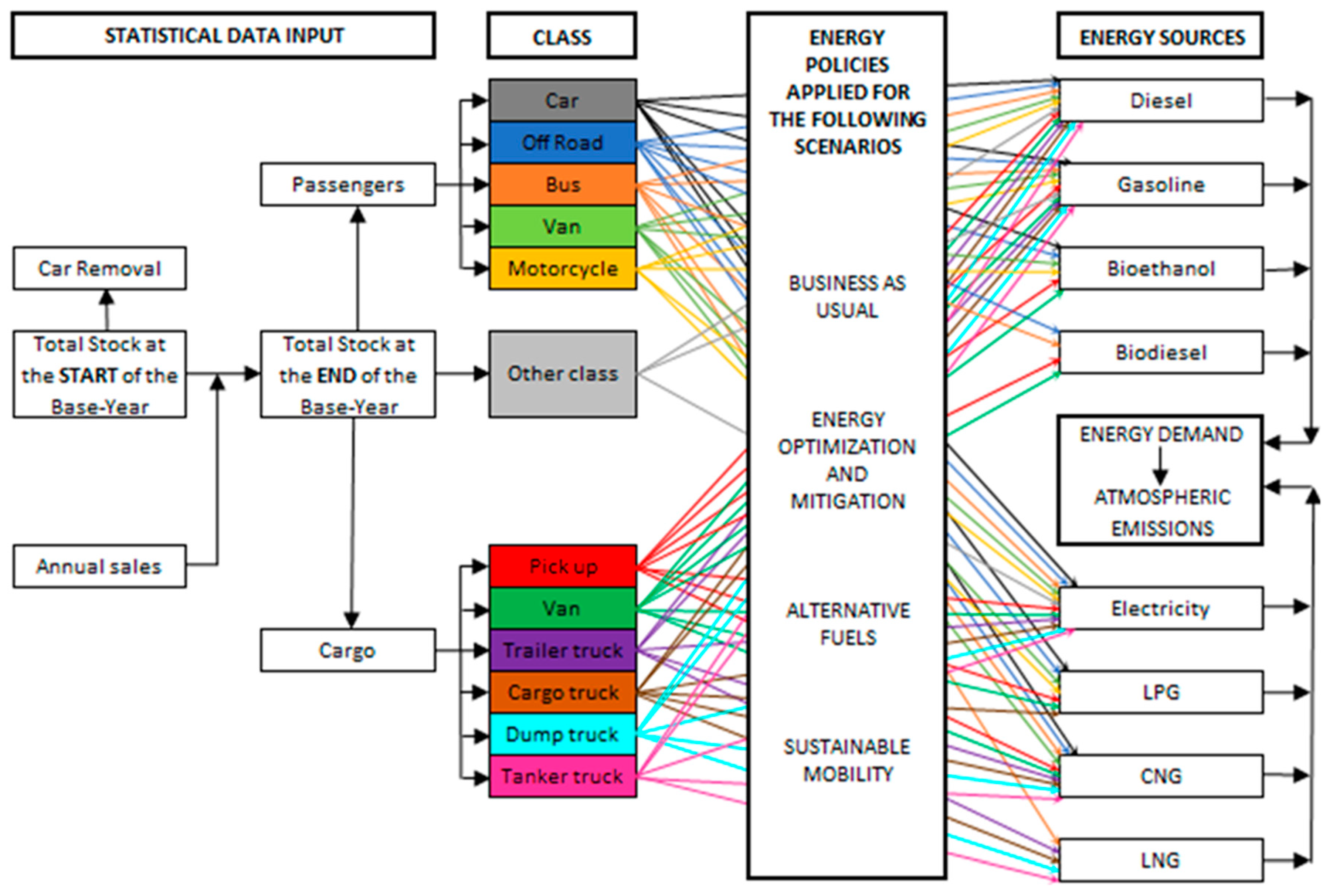
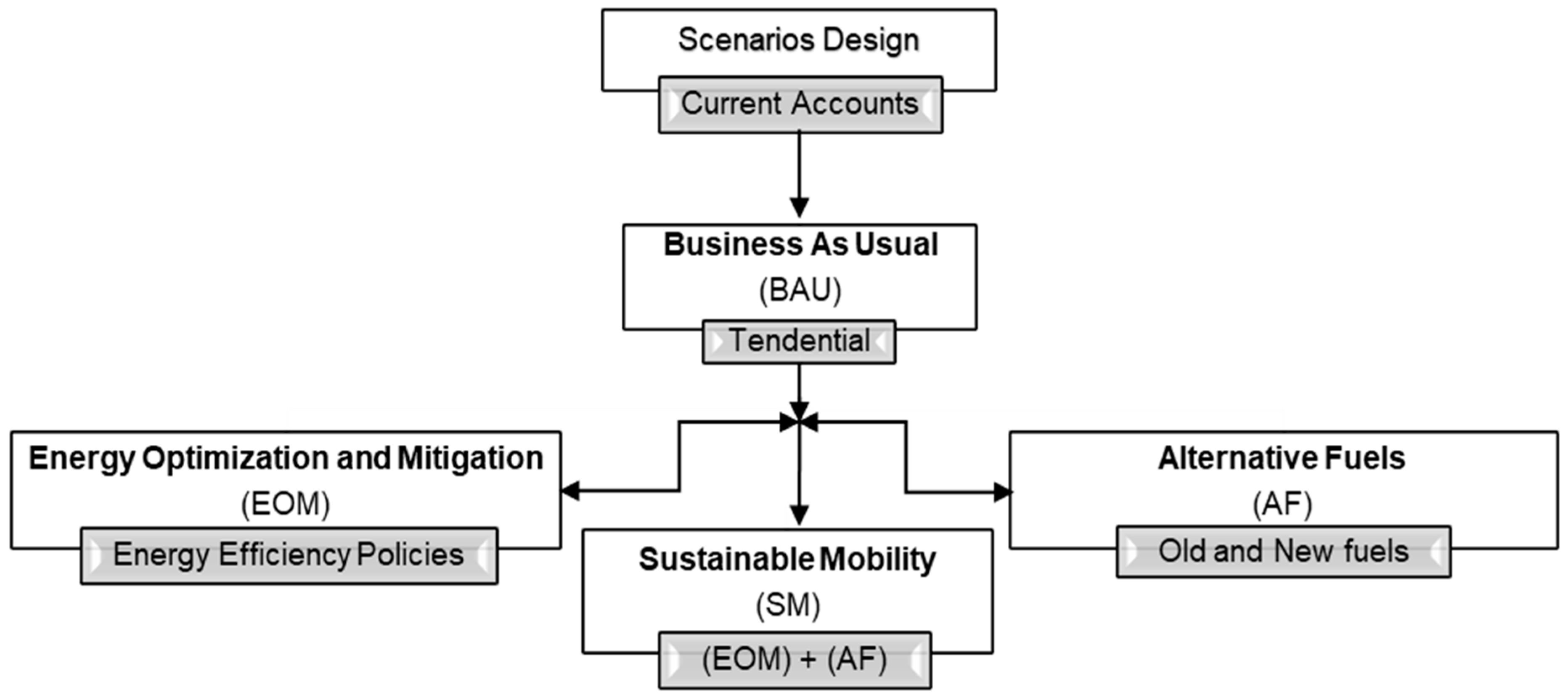
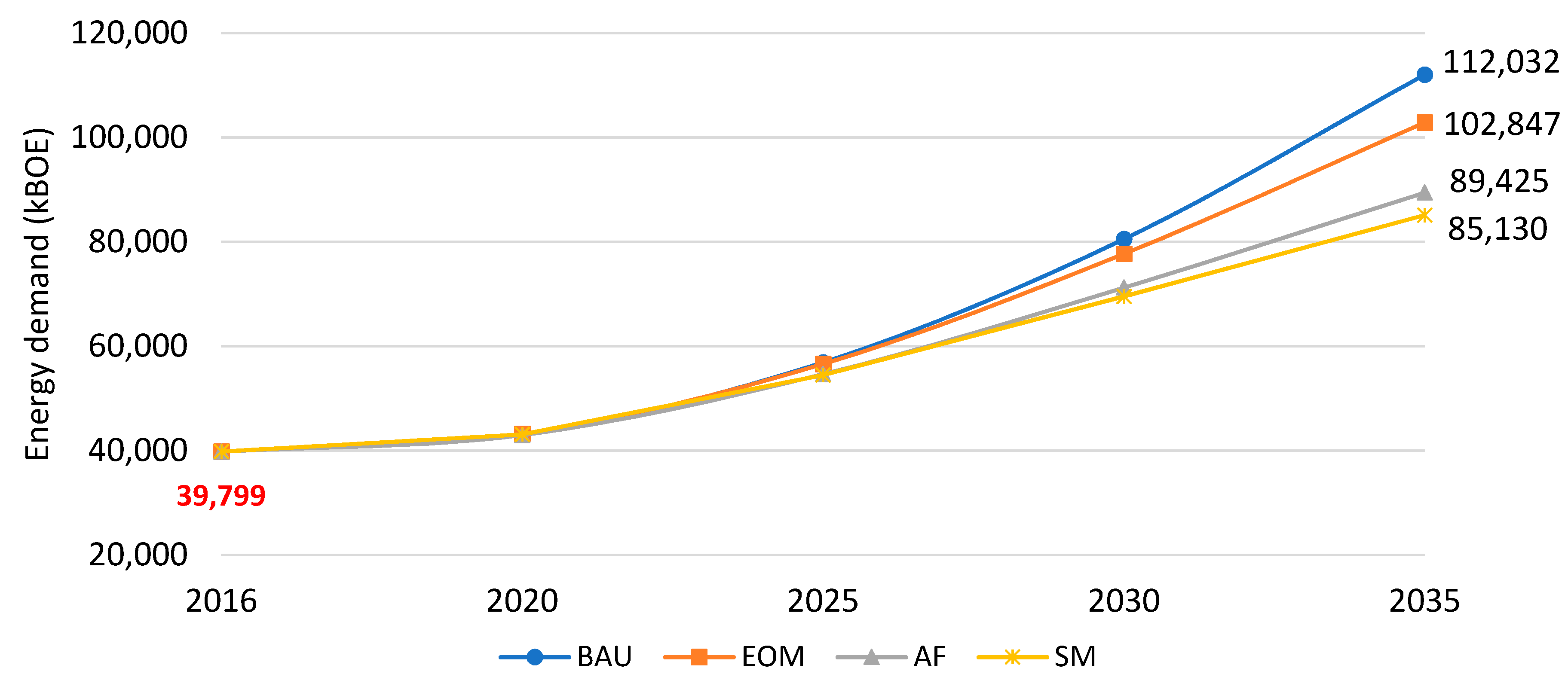
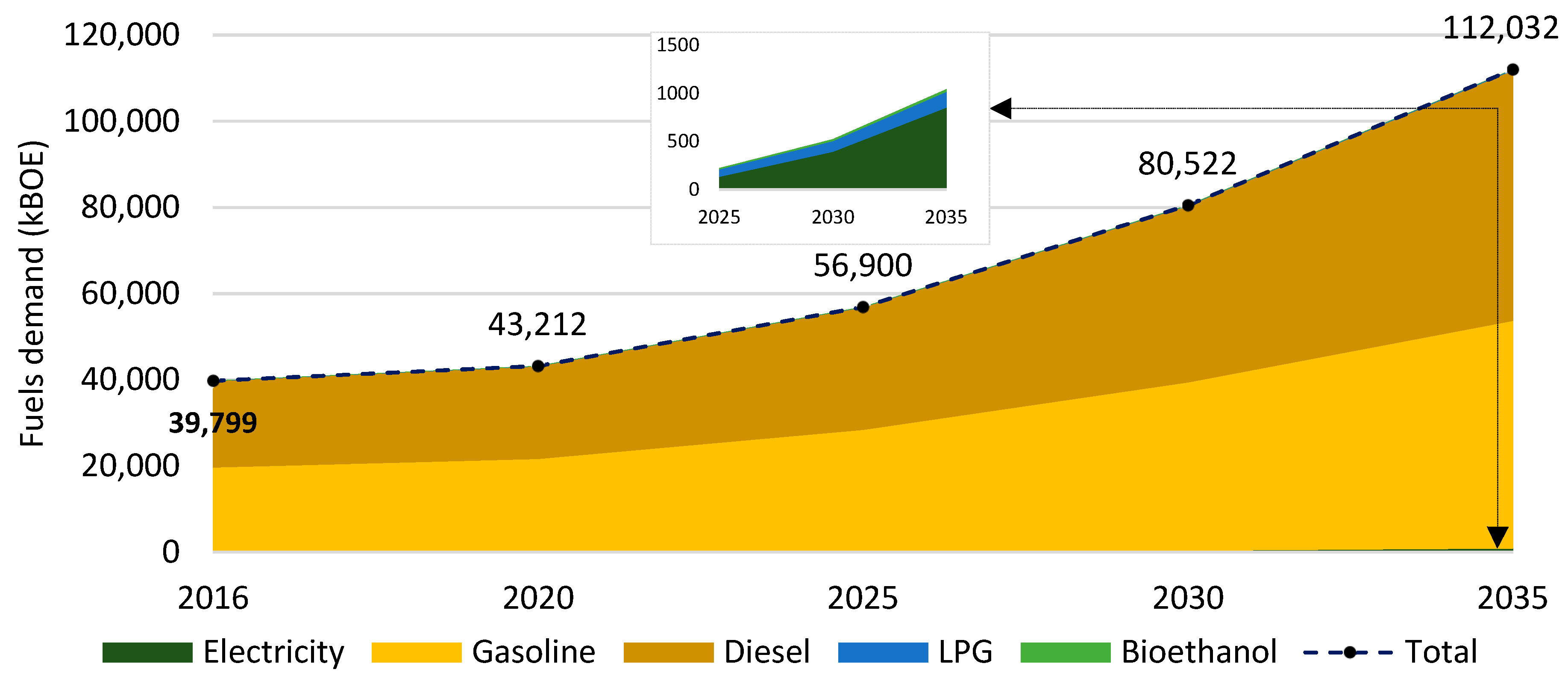
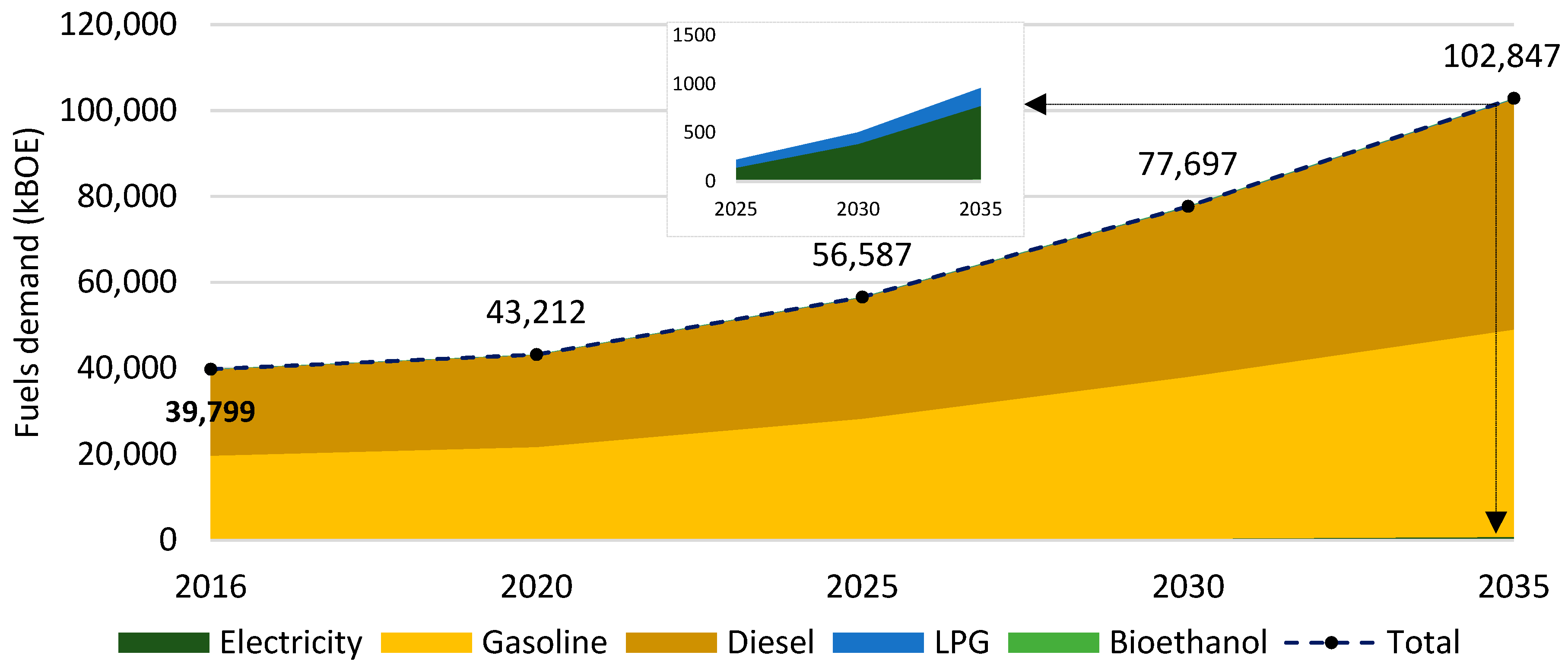
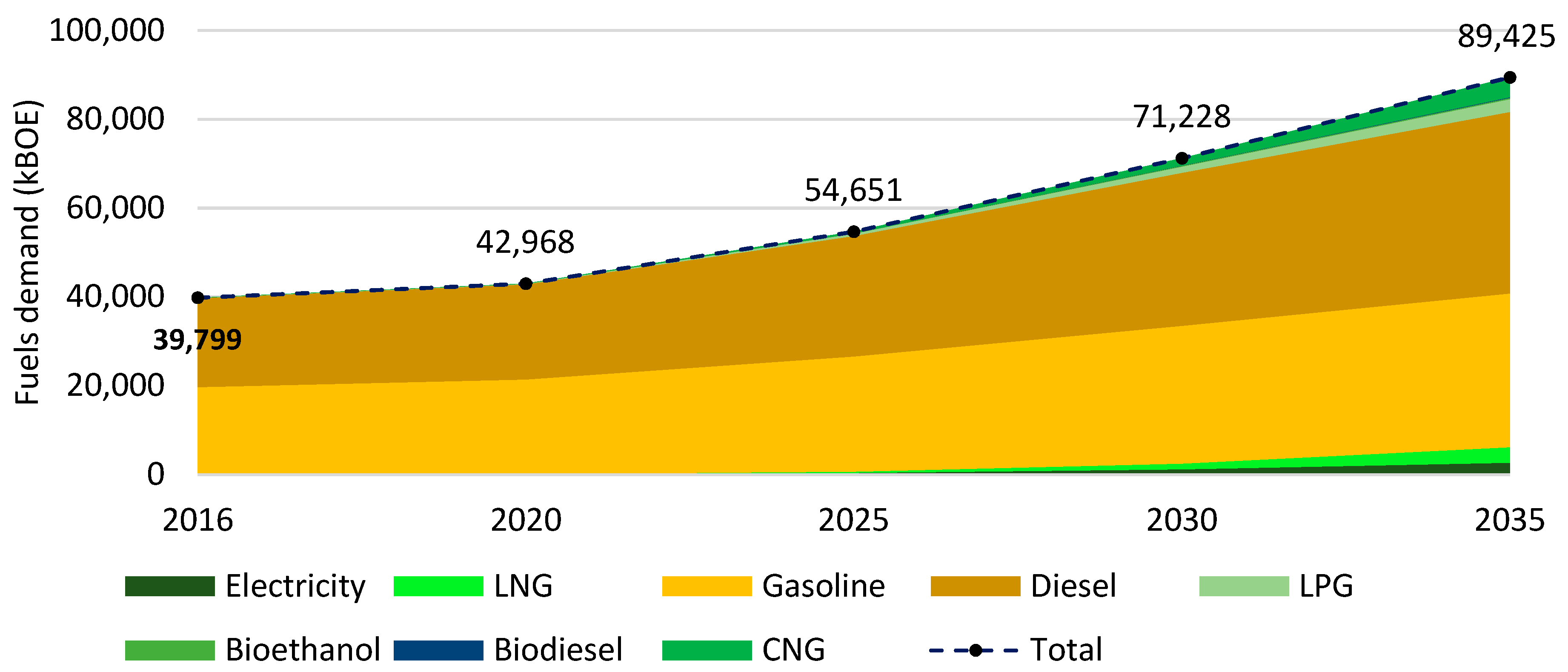
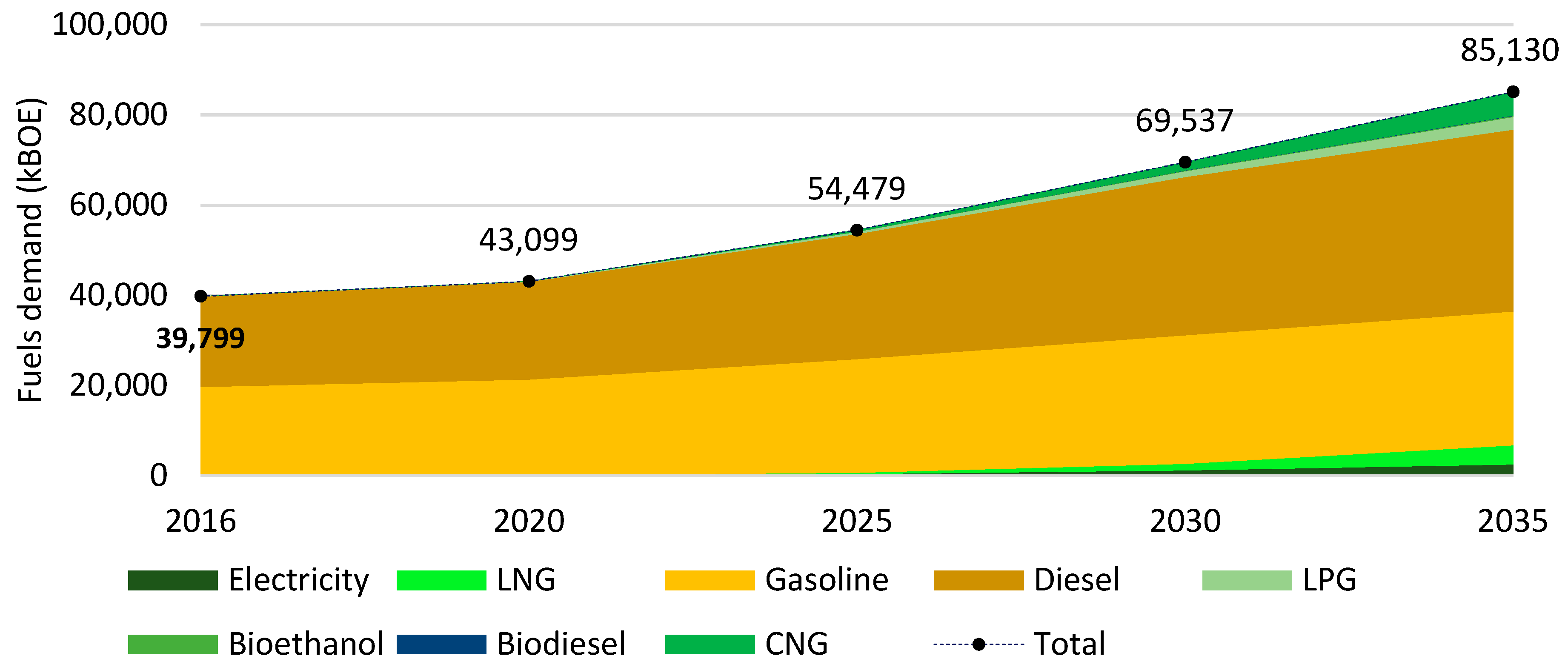
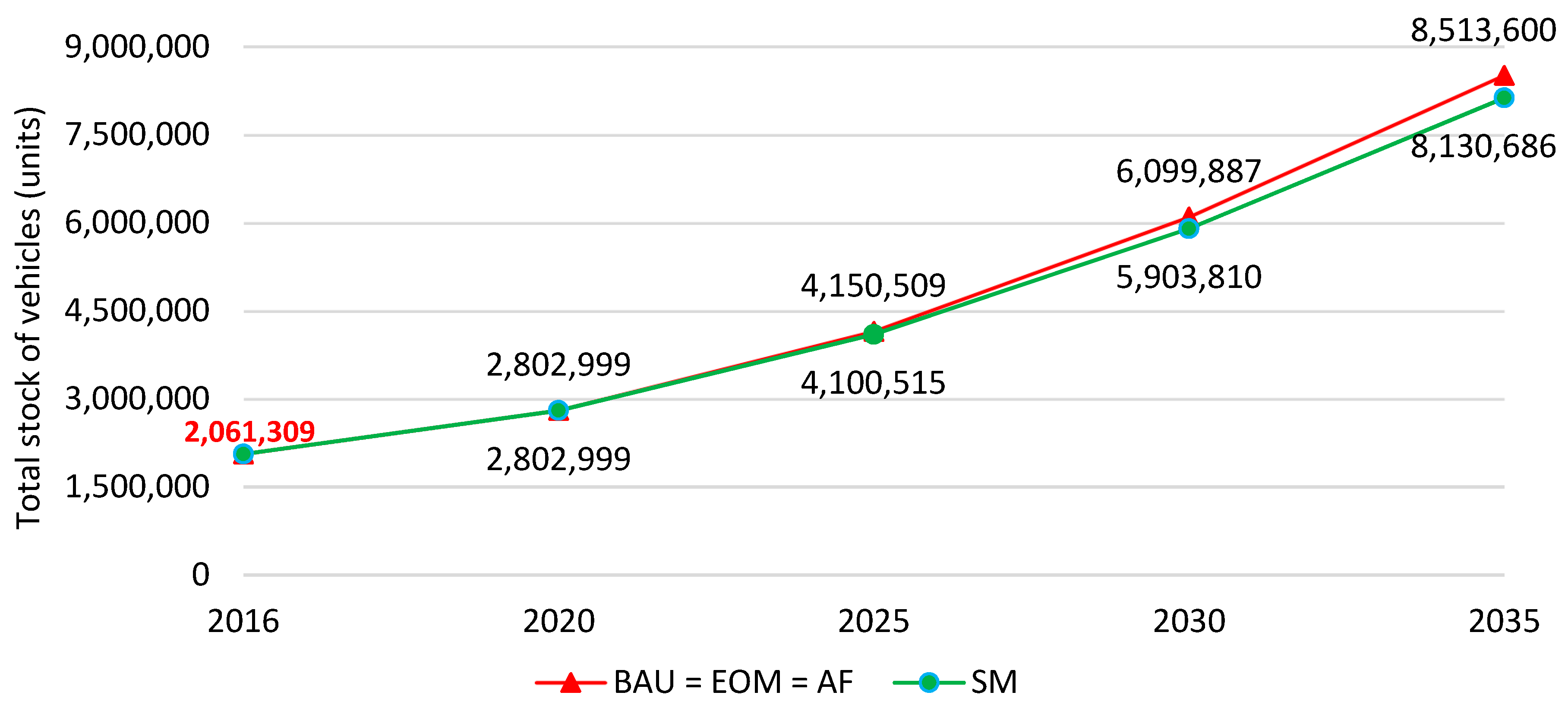
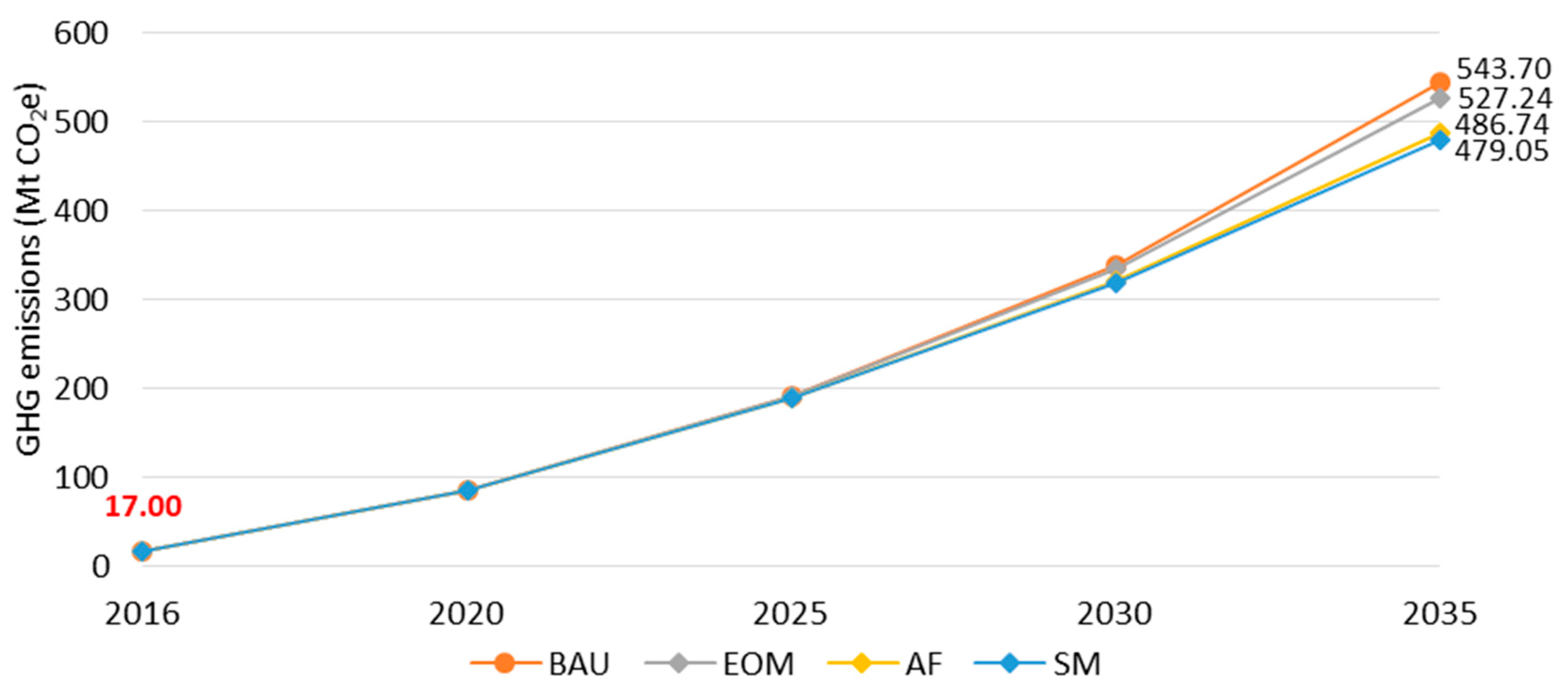
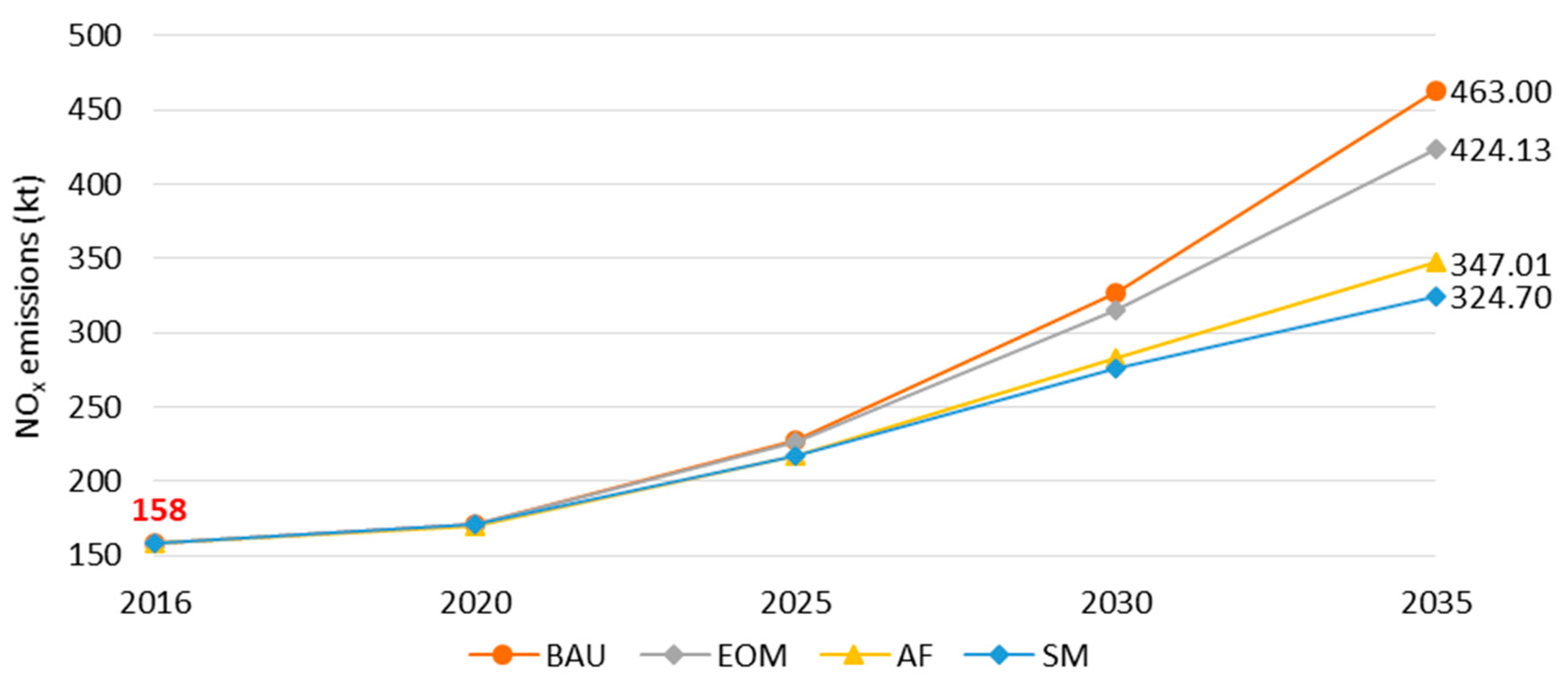
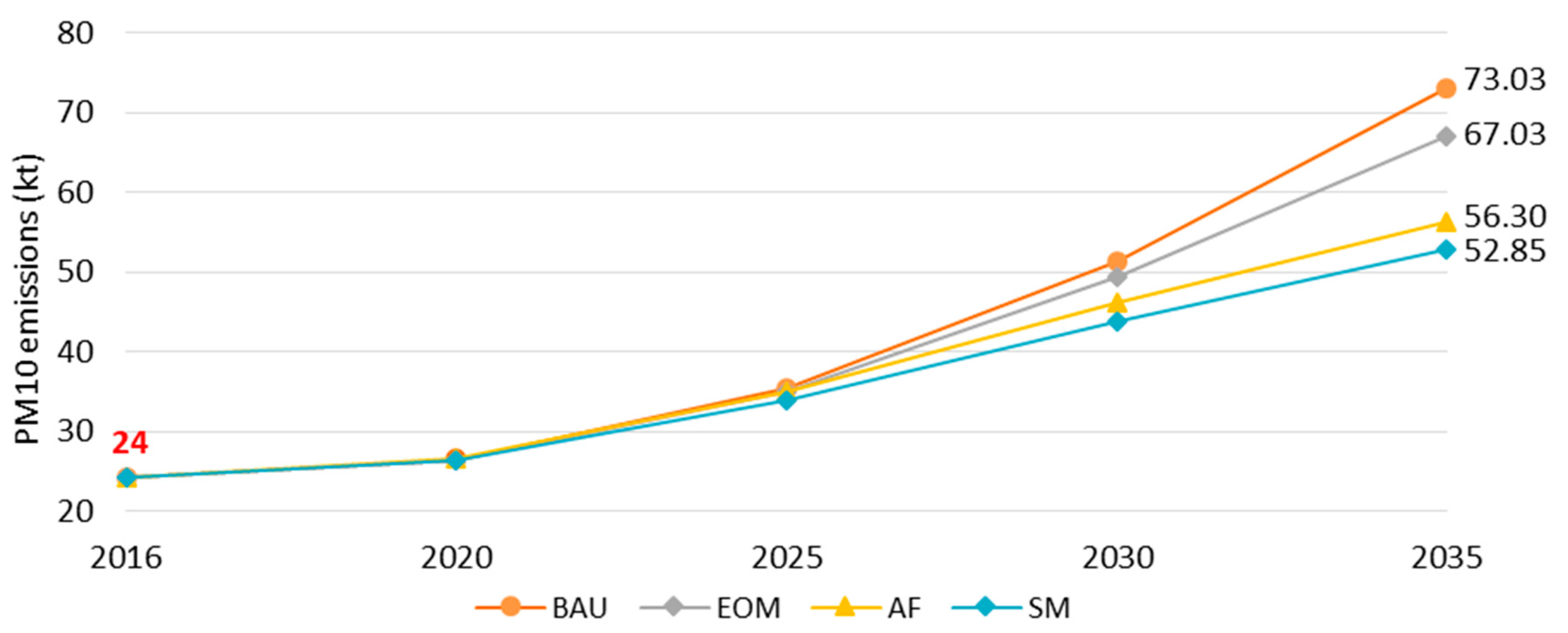
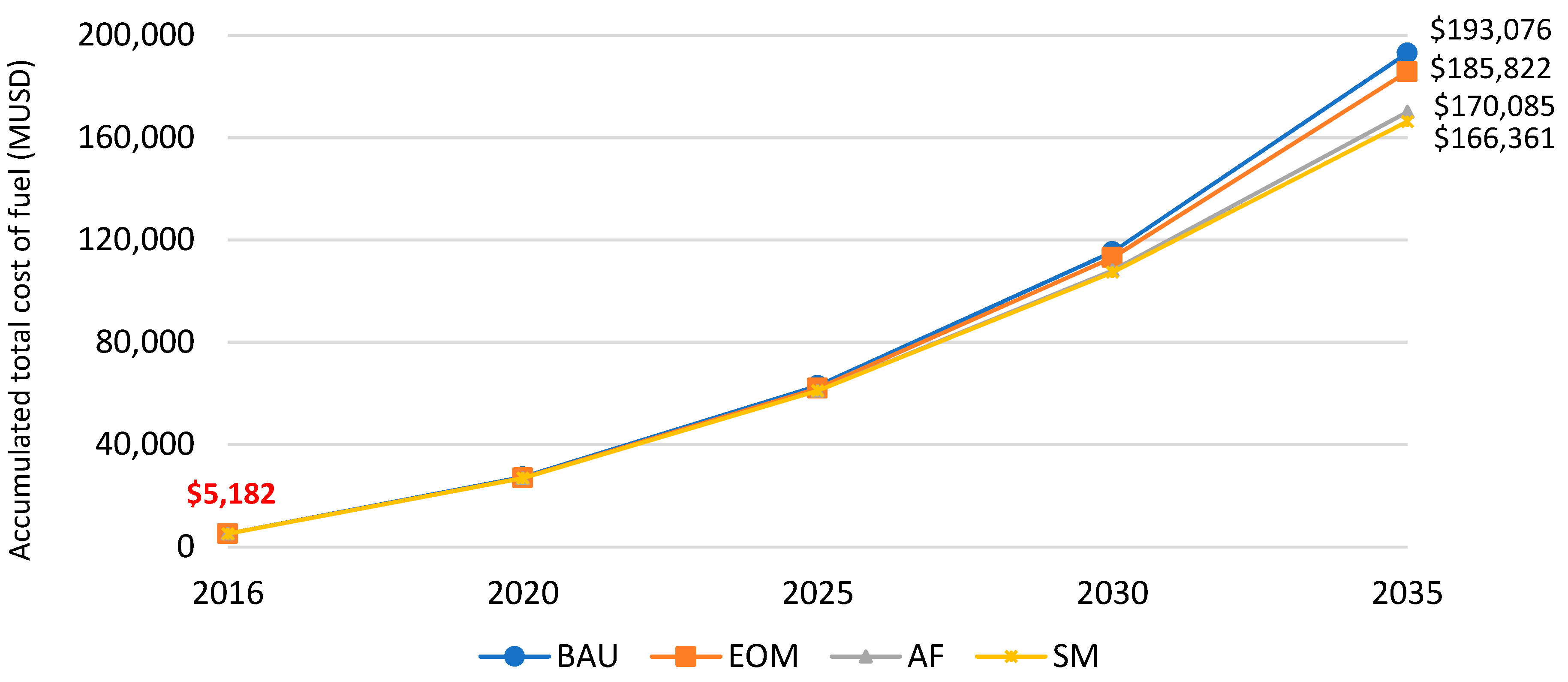
| Registered Vehicles (Units) | Fuel Consumption (kBOE) | |||||||||||
|---|---|---|---|---|---|---|---|---|---|---|---|---|
| Class | Diesel | Gasoline | Hybrid | Electric | LPG | Total | Diesel | Gasoline | Bioethanol | Electricity | LPG | Total |
| Passenger | ||||||||||||
| Car | 1774 | 631,349 | 2993 | 46 | 5134 | 641,296 | 17.29 | 6060.39 | 2.26 | 0.07 | 49.18 | 6129.19 |
| Off-road | 7325 | 313,112 | 2451 | 54 | 56 | 322,998 | 82.61 | 3566.92 | 3.44 | 0.10 | 0.29 | 3653.36 |
| Bus | 23,056 | 380 | - | 96 | - | 23,532 | 2701.01 | 42.04 | - | 5.78 | - | 2748.83 |
| Van | 645 | 23,388 | 1 | 1 | 6 | 24,041 | 18.49 | 804.50 | - | 0.01 | 0.09 | 823.09 |
| Motorcycle | 115 | 477,733 | 4 | 21 | 45 | 477,918 | 0.16 | 736.54 | - | 0.01 | 0.05 | 736.76 |
| Cargo | ||||||||||||
| Pick-up | 83,016 | 320,331 | 115 | 13 | 65 | 403,540 | 1651.89 | 7293.40 | - | 0.06 | 0.63 | 8945.98 |
| Van | 20,284 | 20,976 | 1 | 3 | 4 | 41,268 | 442.10 | 545.45 | - | 0.02 | 0.04 | 987.61 |
| Trailer truck | 9694 | 54 | - | 1 | - | 9749 | 892.21 | 5.01 | - | 0.03 | - | 897.25 |
| Cargo truck | 94,822 | 4078 | - | 2 | 4 | 98,906 | 13,042.10 | 588.61 | - | 0.10 | 0.20 | 13,631.01 |
| Dump truck | 11,500 | 220 | - | - | - | 11,720 | 937.32 | 18.68 | - | - | - | 956.00 |
| Tanker truck | 2178 | 50 | - | - | - | 2228 | 259.04 | 5.75 | - | - | - | 264.79 |
| Other class | ||||||||||||
| Other class | 3649 | 464 | - | - | - | 4113 | 21.90 | 2.82 | - | - | - | 24.72 |
| 258,058 | 1,792,135 | 5565 | 237 | 5314 | 2,061,309 | 20,066.12 | 19,670.11 | 5.70 | 6.18 | 50.48 | 39,798.59 | |
| Passenger | Cargo | ||||||||||||
|---|---|---|---|---|---|---|---|---|---|---|---|---|---|
| Variables | Car | Off-Road | Bus | Van | Motorcycle | Pick-Up | Van | Trailer Truck | Cargo Truck | Dump Truck | Tanker Truck | Other Class | |
| Total vehicles a (2,061,309) | 641,296 | 322,998 | 23,532 | 24,041 | 477,918 | 403,540 | 41,268 | 9749 | 98,906 | 11,720 | 2228 | 4113 | |
| Fuel share b (%) | |||||||||||||
| type | Diesel | 0.28 | 2.27 | 97.97 | 2.68 | 0.02 | 20.57 | 49.15 | 99.44 | 95.87 | 98.12 | 97.76 | 88.72 |
| Gasoline | 80.51 | 79.57 | 1.61 | 97.29 | 99.97 | 79.41 | 50.83 | 0.55 | 4.12 | 1.88 | 2.24 | 11.28 | |
| Ethanol | 18.41 | 18.13 | - | - | - | - | - | - | - | - | - | - | |
| Electricity | 0.01 | 0.01 | 0.42 | 0.01 | - | - | 0.01 | 0.01 | 0.01 | - | - | - | |
| LPG | 0.80 | 0.02 | - | 0.02 | 0.01 | 0.02 | 0.01 | - | - | - | - | - | |
| Average Mileage c (km) | 16,000 | 14,000 | 70,000 | 40,000 | 8300 | 25,000 | 28,000 | 45,000 | 85,000 | 50,000 | 53,000 | 4000 | |
| Average Fuel Economy d (MJ/100 km) | |||||||||||||
| type | Diesel | 376.97 | 493.83 | 1017.82 | 447.55 | 94.24 | 501.37 | 486.29 | 1281.70 | 1014.05 | 1021.59 | 1406.10 | 942.43 |
| Gasoline | 377.27 | 513.86 | 961.41 | 537.06 | 102.77 | 573.53 | 580.16 | 1292.93 | 1064.18 | 1064.18 | 1359.23 | 762.50 | |
| Hybrid (Gasoline) | 238.69 | 364.67 | - | 364.67 | 66.30 | 414.40 | 414.40 | - | - | - | - | 663.04 | |
| Electricity | 64.00 | 82.80 | 423.00 | 108.00 | 18.00 | 126.00 | 126.00 | 432.00 | 360.00 | 360 | 432 | 144 | |
| LPG | 182.48 | 222.15 | - | 232.25 | 72.99 | 243.31 | 232.25 | - | - | - | - | ||
| E5 | 373.23 | 506.17 | - | - | - | 559.74 | - | - | - | - | - | - | |
| CNG | 103.95 | 157..41 | 367.29 | 220.38 | - | 183.65 | 220.37 | 1101.88 | 668.67 | 668.67 | 1101.88 | - | |
| Bi-Fuel | 279.88 | 368.01 | - | - | - | 405.11 | 207.69 | - | - | - | - | - | |
| E10 | 269.20 | 498.48 | - | 524.45 | 100.54 | 560.87 | 566.63 | - | - | - | - | - | |
| B10 | - | 496.47 | 1022.91 | - | - | 504.01 | 488.55 | 1296.78 | 1025.74 | 1033.65 | 1423.82 | - | |
| LNG | - | - | 382.86 | - | - | - | - | 1093.13 | 713.65 | 713.65 | 1069.78 | - | |
| Demand | Passenger | Cargo | |||||||||||
|---|---|---|---|---|---|---|---|---|---|---|---|---|---|
| Variables | Car | Off-Road | Bus | Van | Motorcycle | Pick-Up | Van | Trailer Truck | Cargo Truck | Dump Truck | Tanker Truck | Other Class | |
| Total Sales (Vehicles) | |||||||||||||
| Current Accounts (2016) a | 121,301 | 16,467 | 124 | ||||||||||
| BAU—EOM—AF | 660,000 | 132,000 | 700 | ||||||||||
| SM | 620,000 | 120,000 | 700 | ||||||||||
| Total sales share (%) | |||||||||||||
| Current Accounts (2016) b | 22.89 | 14.05 | 1.17 | 0.70 | 61.18 | 67.23 | 8.79 | 1.91 | 19.34 | 2.29 | 0.44 | - | |
| BAU—EOM—AF | 25.00 | 16.00 | 2.00 | 1.50 | 55.50 | 67.20 | 8.80 | 1.90 | 19.40 | 2.30 | 0.40 | - | |
| SM | 21.00 | 12.00 | 3.00 | 2.00 | 62.00 | 63.00 | 10.30 | 2.20 | 21.50 | 2.50 | 0.50 | - | |
| Sales Share for BAU and EOM scenarios (%) c | |||||||||||||
| type | Diesel | 0.50 | 2.00 | 94.00 | 3.00 | 0.03 | 19.00 | 40.00 | 95.00 | 95.00 | 94.00 | 94.00 | 74.75 |
| Gasoline | 38.45 | 47.95 | 2.00 | 76.95 | 79.97 | 79.00 | 39.95 | 1.00 | 4.00 | 2.00 | 2.00 | 11.50 | |
| Hybrid | 20.00 | 10.00 | - | 10.00 | 10.00 | 1.50 | 10.00 | - | - | - | - | 10.00 | |
| Electricity | 10.00 | 10.00 | - | 10.00 | 10.00 | 0.50 | 10.00 | 4.00 | 1.00 | 4.00 | 4.00 | 4.00 | |
| LPG | 1.05 | 0.05 | 4.00 | 0.05 | - | - | 0.05 | - | - | - | - | - | |
| E5 | 30.00 | 30.00 | - | - | - | - | - | - | - | - | - | - | |
| Sales Share for AF and SM scenarios (%) d | |||||||||||||
| type | Diesel | 0 | 0 | 0 | 0 | 0 | 0 | 0 | 27 | 30 | 30 | 27 | 58.50 |
| Gasoline | 0 | 0 | 0 | 0 | 35 | 0 | 0 | 0 | 0 | 0 | 0 | 11.50 | |
| Hybrid | 25 | 30 | - | 30 | 25 | 15 | 30 | - | - | - | - | 20 | |
| Electricity | 18 | 15 | - | 15 | 15 | 12 | 15 | 8 | 10 | 10 | 8 | 10 | |
| LPG | 17 | 10 | 0 | 12 | - | 10 | 15 | - | - | - | - | - | |
| E5 | 0 | 0 | - | - | - | 5 | - | - | - | - | - | - | |
| CNG | 10 | 15 | 25 | 12 | - | 10 | 7.5 | 15 | 15 | 15 | 15 | - | |
| Bi-Fuel | 3 | 10 | - | - | - | 10 | 7.5 | - | - | - | - | - | |
| E10 | 27 | 17 | - | 31 | 25 | 18 | 10 | - | - | - | - | - | |
| B10 | - | 3 | 36 | - | - | 20 | 15 | 30 | 30 | 30 | 30 | - | |
| LNG | - | - | 25 | - | - | - | - | 20 | 15 | 15 | 20 | - | |
| Description | 2016 | 2020 | 2025 | 2030 | 2035 | |
|---|---|---|---|---|---|---|
| Total Stock of Vehicles (Units) | ||||||
| Scenarios | BAU—EOM—AF | 2,061,309 | 2,802,999 | 4,150,509 | 6,099,887 | 8,513,600 |
| SM | 2,061,309 | 2,802,999 | 4,100,515 | 5,903,810 | 8,130,686 | |
| Total Energy Demand (kBOE) | ||||||
| Scenarios | BAU | 39,799 | 43,212 | 56,900 | 80,522 | 112,032 |
| EOM | 39,799 | 43,212 | 56,587 | 77,697 | 102,847 | |
| AF | 39,799 | 42,968 | 54,651 | 71,228 | 89,425 | |
| SM | 39,799 | 43,099 | 54,479 | 69,537 | 85,130 | |
| Total Fuels Demand (kBOE) | ||||||
| Business As Usual | ||||||
| type | Diesel | 20,066 | 21,473 | 28,409 | 40,962 | 58,164 |
| Gasoline | 19,670 | 21,650 | 28,269 | 39,037 | 52,825 | |
| Electricity | 6 | 27 | 135 | 393 | 854 | |
| LPG | 50 | 57 | 77 | 113 | 164 | |
| Bioethanol | 6 | 7 | 10 | 16 | 25 | |
| Energy Optimization and Mitigation | ||||||
| type | Diesel | 20,066 | 21,473 | 28,249 | 39,534 | 53,576 |
| Gasoline | 19,670 | 21,650 | 28,118 | 37,659 | 48,312 | |
| Electricity | 6 | 27 | 133 | 371 | 754 | |
| LPG | 50 | 57 | 78 | 118 | 183 | |
| Bioethanol | 6 | 7 | 10 | 16 | 23 | |
| Alternative Fuels | ||||||
| type | Diesel | 20,066 | 21,438 | 27,155 | 34,489 | 40,877 |
| Gasoline | 19,670 | 21,332 | 25,928 | 31,001 | 34,618 | |
| Electricity | 6 | 51 | 377 | 1196 | 2672 | |
| LPG | 50 | 123 | 512 | 1388 | 2877 | |
| Bioethanol | 6 | 22 | 70 | 171 | 290 | |
| LNG | - | - | 265 | 1278 | 3472 | |
| CNG | - | - | 344 | 1669 | 4481 | |
| Biodiesel | - | - | - | 35 | 138 | |
| Sustainable Mobility | ||||||
| type | Diesel | 20,066 | 21,640 | 27,738 | 35,088 | 40,340 |
| Gasoline | 19,670 | 21,262 | 25,180 | 28,508 | 29,659 | |
| Electricity | 6 | 52 | 378 | 1157 | 2463 | |
| LPG | 50 | 123 | 479 | 1294 | 2770 | |
| Bioethanol | 6 | 22 | 65 | 151 | 239 | |
| LNG | - | - | 283 | 1469 | 4283 | |
| CNG | - | - | 356 | 1835 | 5243 | |
| Biodiesel | - | - | - | 35 | 133 | |
| Total GHG Emissions (kt CO2e) | ||||||
| Scenarios | BAU | 17,004 | 18,052 | 23,742 | 33,539 | 46,566 |
| EOM | 17,004 | 18,052 | 23,612 | 32,365 | 42,762 | |
| AF | 17,004 | 17,933 | 22,660 | 29,158 | 35,967 | |
| SM | 17,004 | 17,991 | 22,609 | 28,513 | 34,305 | |
| Total Fuel Cost (Million US dollars) | ||||||
| Scenarios | BAU | 5181.94 | 6042.19 | 8077.99 | 12,304.90 | 17,842.52 |
| EOM | 5181.94 | 5859.70 | 8033.58 | 11,872.46 | 16,376.58 | |
| AF | 5181.94 | 5824.61 | 7716.16 | 10,649.30 | 13,537.67 | |
| SM | 5181.94 | 5841.96 | 7687.33 | 10,359.40 | 12,706.02 | |
© 2020 by the authors. Licensee MDPI, Basel, Switzerland. This article is an open access article distributed under the terms and conditions of the Creative Commons Attribution (CC BY) license (http://creativecommons.org/licenses/by/4.0/).
Share and Cite
Rivera-González, L.; Bolonio, D.; Mazadiego, L.F.; Naranjo-Silva, S.; Escobar-Segovia, K. Long-Term Forecast of Energy and Fuels Demand Towards a Sustainable Road Transport Sector in Ecuador (2016–2035): A LEAP Model Application. Sustainability 2020, 12, 472. https://doi.org/10.3390/su12020472
Rivera-González L, Bolonio D, Mazadiego LF, Naranjo-Silva S, Escobar-Segovia K. Long-Term Forecast of Energy and Fuels Demand Towards a Sustainable Road Transport Sector in Ecuador (2016–2035): A LEAP Model Application. Sustainability. 2020; 12(2):472. https://doi.org/10.3390/su12020472
Chicago/Turabian StyleRivera-González, Luis, David Bolonio, Luis F. Mazadiego, Sebastián Naranjo-Silva, and Kenny Escobar-Segovia. 2020. "Long-Term Forecast of Energy and Fuels Demand Towards a Sustainable Road Transport Sector in Ecuador (2016–2035): A LEAP Model Application" Sustainability 12, no. 2: 472. https://doi.org/10.3390/su12020472
APA StyleRivera-González, L., Bolonio, D., Mazadiego, L. F., Naranjo-Silva, S., & Escobar-Segovia, K. (2020). Long-Term Forecast of Energy and Fuels Demand Towards a Sustainable Road Transport Sector in Ecuador (2016–2035): A LEAP Model Application. Sustainability, 12(2), 472. https://doi.org/10.3390/su12020472









